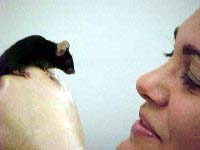World-first gene therapy for cystic fibrosis targets lung stem cells?

PhD student Maria Limberis inspects a CF mouse
The genetically – inherited disease cystic fibrosis causes severe, unrelenting lung disease in children and adults worldwide. Approximately 1 in 2,500 infants are born with this disease and only half survive past 30 years of age.
Now, researchers from the Women’s and Children’s Hospital, Adelaide have developed a novel system of gene therapy for lungs affected by cystic fibrosis, involving a natural compound found in our lungs which ’conditions’ lung airways to allow cells to take up the therapeutic gene.
Our lungs have developed highly effective ways to protect us from allergens, irritants, dust, viruses and other foreign particles. But according to principal medical scientist in Pulmonary Medicine, Dr David Parsons these defences also hinder effective gene therapy in our lungs.
“Using a mouse model of cystic fibrosis Maria Limberis, a PhD student in our lab, has helped us develop a system to briefly overcome these defences. As the cells lining the mouse nose behave in much the same way as human lung cells – this enables us to use the nose airways in mice to easily develop and test out gene therapy treatments.
“By instilling a single dose of a detergent found naturally in low amounts in our lungs, we are able to ’condition’ cells to take up the gene needed to treat cystic fibrosis.
” Viruses are very good at transferring their genetic material into cells and we make use of this by getting useful parts of an inactive and highly-modified human immunodeficiency virus type 1 (HIV 1) to safely transfer the cystic fibrosis gene into cells. We use this modified HIV because it is one of the few viruses that can give long-lasting gene transfer,” Dr Parsons says.
Using this system, the research team has shown, for the first time in a living animal, that long-lived gene therapy for cystic fibrosis is possible. Not only do the airway cells take up the correcting gene, but these cells also show substantial recovery from the cystic fibrosis defect for, so far, at least 110 days.
“Airway cells are replaced every three months so our findings are particularly exciting because they imply we are in fact targeting airway stem cells through this approach – some of the therapeutic gene must have been passed on from these parent stem cells to their daughter cells for the effect to persist beyond three months,” Dr Parsons says.
Research funding is now being sought to establish the most effective dose and timing for giving the detergent together with rigorous safety checks on the highly modified HIV-1 based virus particle used for the gene transfer.
Another senior member of the team, molecular biologist Dr Don Anson, explains, “Last year we published a method which vastly increases the safety with which HIV-1 can be modified and used to transfer genes without causing disease.
“We are now working to further improve on this method in order that patients and their families will feel totally confident to eventually take part in human trials of this gene therapy for cystic fibrosis,” Dr Anson says.
The work from this research is to be published in Human Gene Therapy, volume 13 #16 on October 20.
Members of the Research Team are:
Dr David Parsons (Medical Scientist, Pulmonary Medicine)
Dr Don Anson (Senior Molecular Biologist, Chemical Pathology)
Dr Maria Fuller (Molecular Biologist, Chemical Pathology)
Ms Maria Limberis (PhD student, Pulmonary Medicine)
Media Contact
More Information:
http://www.wch.sa.gov.au/All latest news from the category: Health and Medicine
This subject area encompasses research and studies in the field of human medicine.
Among the wide-ranging list of topics covered here are anesthesiology, anatomy, surgery, human genetics, hygiene and environmental medicine, internal medicine, neurology, pharmacology, physiology, urology and dental medicine.
Newest articles

Superradiant atoms could push the boundaries of how precisely time can be measured
Superradiant atoms can help us measure time more precisely than ever. In a new study, researchers from the University of Copenhagen present a new method for measuring the time interval,…

Ion thermoelectric conversion devices for near room temperature
The electrode sheet of the thermoelectric device consists of ionic hydrogel, which is sandwiched between the electrodes to form, and the Prussian blue on the electrode undergoes a redox reaction…

Zap Energy achieves 37-million-degree temperatures in a compact device
New publication reports record electron temperatures for a small-scale, sheared-flow-stabilized Z-pinch fusion device. In the nine decades since humans first produced fusion reactions, only a few fusion technologies have demonstrated…





















